2021-02-04 - Nº 301
Editorial
Esta é a Newsletter Nº 301 que se apresenta com o mesmo formato que as anteriores. Se gostar da Newsletter partilhe-a!
Todas as Newsletters encontram-se indexadas no link.
Esta Newsletter tem os seguintes tópicos:
Faz hoje anos que nascia, em 1875, o físico alemão Ludwig Prandtl. Ele é conhecido pelo seus estudos de aerodinâmica e hidrodinâmica. Ele estabeleceu a existência da camada limite adjacente à superfície de um sólido sobre o qual flui um fluido. O desenho de uma forma, peso e massa eficientes para navios e aeronaves deve muito ao seu trabalho, pelo qual ele é considerado o pai da aerodinâmica. Ele fez grandes estudos sobre os efeitos da racionalização e as propriedades das asas de aeronaves. Ele fez melhorias em construções como túneis de vento. O número de Prandtl é um grupo adimensional usado no estudo da convecção. A equação de von Karman-Prandtl descreve a variação logarítmica da velocidade da água dentro de um canal de fluxo zero no leito do riacho a uma velocidade máxima na superfície da água.
Faz também hoje anos que nascia, em 1896, o físico alemão Friedrich Hund. Ele ficou conhecido pelo seu trabalho sobre a estrutura electrónica de átomos e moléculas. Ele introduziu um método de uso de orbitais moleculares para determinar a estrutura electrónica das moléculas e a formação de ligações químicas. As suas regras empíricas de Hund (1925) para espectros atómicos determinam o nível de energia mais baixo para dois electrões com os mesmos n e l números quânticos num átomo de muitos electrões (1). O estado de menor energia tem a multiplicidade máxima consistente com o princípio de exclusão de Pauli. O estado de menor energia tem o número quântico total máximo do momento angular orbital do electrão, consistente com a regra (1). Eles são explicados pela teoria quântica dos átomos por cálculos envolvendo a repulsão entre dois electrões.
Faz igualmente hoje anos que nascia, em 1902, o aviador norte-americano Charles Lindbergh. Ele fez o primeiro voo sozinho sem escalas, em 1927, através do Atlântico. Em 20 de maio de 1927, Lindbergh partiu de Nova York para Paris, carregando sanduiches e água. Ele decidiu não carregar pára-quedas e rádio, preferindo mais gasolina. Ele lutou contra a névoa, o gelo e a sonolência e pousou em Paris em 21 de maio, após 33 horas e meia em seu voo de cerca de 5.800 Km.
Faz também hoje anos que nascia, em 1906, o astrónomo norte-americano Clyde Tombaugh. Ele descobriu Plutão, então conhecido como planeta. Ele tinha 24 anos, trabalhava no Observatório Lowell, Flagstaff, Arizona, quando o localizou em 13 de Março de 1930. Ele estava comparando uma chapa fotográfica tirada a 23 de Janeiro de 1930, com outra feita alguns dias depois, e viu um ponto que mudou de posição entre elas. Assim terminou uma busca sistemática de décadas instigada pelas previsões de outros astrónomos. Tombaugh também descobriu vários aglomerados de estrelas e galáxias, estudou a distribuição aparente de nebulosas extra-galácticas e fez observações das superfícies de Marte, Vénus, Júpiter, Saturno e da Lua. Plutão foi o único planeta descoberto no século 20 e o único encontrado por um norte-americano.
Faz igualmente hoje anos que nascia, em 1925, o Matemático inglês, nascido no Japão, Christopher Zeeman. Ele é conhecido pelo seu trabalho promovendo a teoria da catástrofe depois que ela foi introduzida na década de 1960 pelo matemático francês René Thom. Tal teoria diz que a probabilidade de que eventos repentinos ocorrerão pode ser prevista marcando os desenvolvimentos matematicamente. Um exemplo sobre o qual Zeeman escreveu como um evento repentino é para água aquecida quando começa a ferver. Como outras áreas de aplicabilidade, ele oferece uma gama de disciplinas tão diversas quanto equilíbrios pontuados em evolução, meteorologia e psicologia comportamental. Este último aplicaria matemática para analisar situações de sequestro ou refém.
Faz também hoje anos que nascia, em 1927, o físico norte-americano nascido na Alemanha Rolf Landauer. Ele é conhecido pela sua formulação do princípio de Landauer sobre a energia usada durante a operação de um computador. Sempre que a máquina é reiniciada para outro cálculo, os bits são libertados da memória do computador e, nessa operação electrónica, uma certa quantidade de energia é perdida. Assim, quando a informação é apagada, há um inevitável "custo termodinâmico do esquecimento", que governa o desenvolvimento de computadores mais eficientes em termos de energia. Enquanto os engenheiros lidavam com as limitações práticas de compactar cada vez mais circuitos em minúsculos chips, Landauer considerou o limite teórico de que, se a tecnologia melhorasse indefinidamente, em quanto tempo ela barraria com as fronteiras insuperáveis estabelecidas pela natureza?
Por fim, faz hoje anos que nascia, em 1943, o pioneiro norte-americano da ciência da computação Ken Thompson. Ele trabalhou na Bell Labs durante a maior parte de sua carreira, onde projectou e implementou o sistema operativo Unix original. Ele também inventou a linguagem de programação B, a predecessora directa da linguagem de programação C, e foi um dos criadores do sistema operativo Plan 9. Desde 2006, Thompson trabalha no Google, onde co-inventou a linguagem de programação Go. Outras contribuições notáveis incluíram seu trabalho em expressões regulares e primeiros editores de texto de computador QED e ed, a definição da codificação UTF-8 e seu trabalho em xadrez de computador que incluiu a criação de bases de mesa de final de jogo e a máquina de xadrez Belle. Ele ganhou o Prémio Turing em 1983 com seu colega de longa data Dennis Ritchie.
E nesta semana que passou, e depois de alguns adiamentos, a SpaceX lançou o foguetão SN9. A missão não teve o fim esperado uma vez que o foguetão explodiu à aterragem tendo o mesmo final que o seu antecessor, o SN8. O foguetão de três motores voou até uma altitude de 10 quilómetros, desligando então os seus motores em sequência enquanto subia mais alto. De seguida, começou uma longa queda de volta à Terra, como fez seu antecessor SN8 durante um voo de teste em Dezembro. Ao chegar para aterrar, o SN9 executou uma queima final para se orientar verticalmente, então deu-se a aterragem que foi violenta e não totalmente vertical, explodindo no impacto.
Também nesta semana que passou, a SpaceX teve outra missão, esta sim com sucesso, colocando mais 60 satélites Starlink usando um foguetão que bateu o recorde de utilizações conseguindo aterrar com sucesso. O foguetão Falcon 9 de dois estágios, fez um voo de cerca de 9 minutos, retornando à Terra e aterrando numa das barcaças que se encontra no oceano Atlântico. A barcaça gigante "Of Course I Still Love You," é uma das duas que tem o trabalho de recolher os foguetões lançados. Este foi o quinto lançamento deste primeiro estágio do Falcon 9, que tinha voado pela última vez há apenas 27 dias - a reutilização mais rápida entre as missões para qualquer foguetão SpaceX. O lançamento de hoje também foi o primeiro de duas descolagens Starlink quase consecutivas; outros 60 satélites estão programados para voar na manhã de sexta-feira (5 de Fevereiro) noutro Falcon 9 diferente.
Na Newsletter desta semana apresentamos diversas noticias, artigos científicos assim como projetos de maker.
 João Alves ([email protected])
João Alves ([email protected])
O conteúdo da Newsletter encontra-se sob a licença  Creative Commons Attribution-NonCommercial-ShareAlike 4.0 International License.
Creative Commons Attribution-NonCommercial-ShareAlike 4.0 International License.
Novidades da Semana

SpaceX Starship SN9 flies high, explodes on landing just like SN8
"After delays and a flap with the FAA, the Mars rocket prototype ran a vertical 10K on Tuesday. The second flight of a prototype of Elon Musk's next-generation Starship rocket, meant for eventual trips to Mars, was picture-perfect right up until the landing, which like the test of an earlier prototype, ended in a fiery explosion on Tuesday. After several delays and a dust-up with the Federal Aviation Administration over its launch license, SpaceX launched the vehicle dubbed SN9 from its Boca Chica, Texas, facility at around 12:30 p.m. PT. The three-engine rocket flew to an altitude of 6.2 miles (10 kilometers), shutting off its three engines in sequence as it climbed higher. It then began a long fall back to Earth, as its predecessor SN8 did during a test flight in December. As it came in for a landing, SN9 executed a landing burn to orient itself vertically for touchdown, then appeared to land hard and not quite vertical, exploding on impact just as SN8 did." [...]

SpaceX launches 60 Starlink satellites on record-setting used rocket, nails landing
"SpaceX launched 60 more Starlink internet satellites to orbit this morning (Feb. 4) on a mission that notched a booster-reusability milestone for the company. A two-stage Falcon 9 rocket topped with the 60 broadband spacecraft lifted off from Space Launch Complex 40 here at Cape Canaveral Space Force Station today at 1:19 a.m. EST (0619 GMT). Approximately nine minutes later, the rocket's first stage returned to Earth, landing smoothly on one of SpaceX's drone ships in the Atlantic Ocean. The massive ship, "Of Course I Still Love You," is one of two SpaceX vessels that catch falling boosters and return them to port. It was the fifth launch for this Falcon 9 first stage, which last flew just 27 days ago — the quickest turnaround between missions for any SpaceX booster. Today's launch was also the first of two nearly back-to-back Starlink liftoffs; another 60 satellites are scheduled to take flight early Friday morning (Feb. 5) on a different Falcon 9." [...]
Outras Notícias

The Dunant subsea cable, connecting the US and mainland Europe, is ready for service
"We’re thrilled to say bonjour to the Dunant submarine cable system, which has been deployed and tested and is now ready for service. Crossing the Atlantic Ocean between Virginia Beach in the U.S. and Saint-Hilaire-de-Riez on the French Atlantic coast, the system expands Google’s global network to add dedicated capacity, diversity, and resilience, while enabling interconnection to other network infrastructure in the region. It’s named in honor of Swiss businessman and social activist Henry Dunant, the founder of the Red Cross and first recipient of the Nobel Peace Prize. The historic landing was made possible in partnership with SubCom, a global partner for undersea data transport, which engineered, manufactured and installed the Dunant system on schedule despite the ongoing global pandemic. Delivering record-breaking capacity of 250 terabits per second (Tbps) across the Atlantic As we shared when we originally announced the Dunant cable, Dunant is the first long-haul subsea cable to feature a 12 fiber pair space-division multiplexing (SDM) design, and will deliver record-breaking capacity of 250 terabits per second (Tbps) across the ocean—enough to transmit the entire digitized Library of Congress three times every second. Increased cable capacity is delivered in a cost-effective manner with additional fiber pairs (twelve, rather than six or eight in past generations of subsea cables) and power-optimized repeater designs." [...]
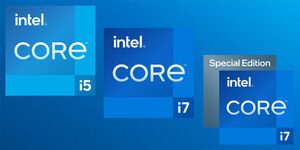
11th Gen H35 Processors: Fastest Single-Threaded Laptop Performance
"The 11th Gen Intel® Core™ H35 processors, the newest of Intel’s H-series processors, are designed for ultraportable gaming on laptops. Packed with incredible gaming performance in an ultraportable form factor, the processors balance mobility and enthusiast-level gaming. The 11th Gen Intel Core i7-11375H Special Edition headlines the new H35 processors, and utilizes Intel® Turbo Boost Max 3.0 to deliver up to 5GHz Turbo frequencies. Up to 5GHz: The 11th Gen Intel Core i7-11375H Special Edition delivers the fastest single-threaded performance of any laptop processor and is matched only by the 10th Gen Intel Core i9-10980HK. Game Anywhere: 11th Gen Intel Core H35 processors enable enthusiast level gaming on the go. Users can play a majority of popular esports and AAA games in full high definition at high settings with the 11th Gen Intel Core i7-11375H Special Edition processor." [...]

The Truck Stops Here: How AI Is Creating a New Kind of Commercial Vehicle
"For many, the term “autonomous vehicles” conjures up images of self-driving cars. Autonomy, however, is transforming much more than personal transportation. Autonomous trucks are commercial vehicles that use AI to automate everything from shipping yard operations to long-haul deliveries. Due to industry pressures from rising delivery demand and driver shortages, as well as straightforward operational domains such as highways, these intelligent trucks may be the first autonomous vehicles to hit public roads at scale. This technology uses long-range, high-resolution sensors, a range of deep neural networks and high-performance, energy-efficient compute to improve safety and efficiency for everyday logistics. With the rise of e-commerce and next-day delivery, trucking plays an increasingly vital role in moving the world forward." [...]
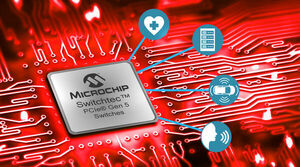
Microchip Accelerates Machine Learning and Hyperscale Computing Infrastructure with the World’s First PCI Express® 5.0 Switches
"Switchtec™ PFX PCIe® Gen 5 high performance switches double the data rate of PCIe Gen 4.0 solutions while delivering ultra-low latency and advanced diagnostics Applications such as data analytics, autonomous-driving and medical diagnostics are driving extraordinary demands for machine learning and hyperscale compute infrastructure. To meet these demands, Microchip Technology Inc. (Nasdaq: MCHP) today announced the world’s first PCI Express (PCIe) 5.0 switch solutions — the Switchtec PFX PCIe 5.0 family — doubling the interconnect performance for dense compute, high speed networking and NVM Express® (NVMe®) storage. Together with the XpressConnect™ retimers, Microchip is the industry’s only supplier of both PCIe Gen 5 switches and PCIe Gen 5 retimer products, delivering a complete portfolio of PCIe Gen 5 infrastructure solutions with proven interoperability. “Accelerators, graphic processing units (GPUs), central processing units (CPUs) and high-speed network adapters continue to drive the need for higher performance PCIe infrastructure. Microchip’s introduction of the world’s first PCIe 5.0 switch doubles the PCIe Gen 4 interconnect link rates to 32 GT/s to support the most demanding next-generation machine learning platforms,” said Andrew Dieckmann, associate vice president of marketing and applications engineering for Microchip’s data center solutions business unit. “Coupled with our XpressConnect family of PCIe 5.0 and Compute Express Link™ (CXL™) 1.1/2.0 retimers, Microchip offers the industry’s broadest portfolio of PCIe Gen 5 infrastructure solutions with the lowest latency and end-to-end interoperability.” The Switchtec PFX PCIe 5.0 switch family comprises high density, high reliability switches supporting 28 lanes to 100 lanes and up to 48 non-transparent bridges (NTBs)." [...]

MediaTek Unveils New M80 5G Modem with Support for mmWave and Sub-6 GHz 5G Networks
"New modem supports SA and NSA architectures, with a peak speed of 7.67 Gbps MediaTek today announced its new M80 5G modem which combines mmWave and sub-6 GHz 5G technologies onto a single chip. The M80 supports ultra-fast speeds on both non-standalone (NSA) and standalone (SA) architectures, with a peak rate of 7.67 Gbps in the downlink and 3.76 Gbps in the uplink. The M80 also supports dual 5G SIM, dual 5G NSA and SA networks, and dual Voice over New Radio (VoNR) for more reliable connectivity. “As 5G rollouts accelerate, mmWave is becoming increasingly important, especially in the U.S. MediaTek’s new 5G modem integrates support for both sub-6 GHz and mmWave networks to address this opportunity and give device makers more flexibility,” said JC Hsu, Corporate Vice President and General Manager of MediaTek's Wireless Communications Business Unit. “To advance users’ 5G experiences, the new modem supports the latest global cellular standards and specifications and it packs MediaTek’s signature power savings technologies along with ultra-fast speeds.” MediaTek’s 5G modems are ideal for a range of devices, including smartphones, PCs, Mi-Fi hotspots, broadband customer premise equipment (CPE), industrial IoT applications and more. MediaTek’s first generation 5G modem, the M70, is built into MediaTek’s Dimensity series of powerful and power-efficient chipsets for 5G smartphones." [...]
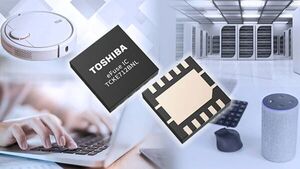
Toshiba Adds New eFuse IC, an Electronic Fuse for Repeated Use that Offers Adjustable Overvoltage Protection and FLAG Signal Output Function
"Toshiba Electronic Devices & Storage Corporation ("Toshiba") has added a new eFuse IC, “TCKE712BNL,” to its line-up of eFuse ICs for repeated use that support functions to protect power line circuits. Conventional physical fuses—glass tube fuses and chip fuses—protect power line circuits by physically shutting them down when they are in an over-current state, and once used and broken must be replaced. eFuse ICs are designed to replace such fuses in providing power line circuit protection and safety, and to deliver a range of built-in protection functions in addition to highly accurate overcurrent protection. TCKE712BNL protects power lines with an overvoltage protection function that can be adjusted to user requirements with external resistors. It also has a built-in reverse blocking current function in the OFF state, allowing use in power multiplexer applications. In addition, its built-in protection functions cover overcurrent, short-circuit and overtemperature." [...]
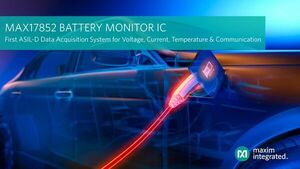
Maxim Integrated Unveils Industry’s First Data Acquisition System to Achieve ASIL-D Compliance for Voltage, Current, Temperature and Communication of a Battery Management System
"MAX17852 battery monitor IC with integrated current sense amplifier offers up to 16 percent space savings and up to 20 percent cost savings Designers of automotive battery management systems (BMS) can now deliver the highest level of safety for voltage, current, temperature and communication while also saving space and reducing solution cost, with the MAX17852 14-channel, high-voltage, ASIL-D data-acquisition system from Maxim Integrated Products, Inc. (NASDAQ: MXIM). Designed for integration within electric vehicles, hybrid electric vehicles and other transportation systems, the IC is ideal for smart junction box, 48V and other automotive battery systems which can see voltages up to 400V and beyond. OEMs and electric vehicle manufacturers require that all battery systems meet the highest safety requirements set by the ISO26262 guidelines. Through comprehensive diagnostics and a safety-driven architecture, Maxim Integrated designed and manufactured the MAX17852 to enable customers to design their systems to meet the highest ASIL-D standards for voltage, current, temperature and communication. The small, cost effective IC also offers the highest accuracy for delivering voltage, current and temperature data with tight time synchronization. It allows a typical cell voltage measurement of ±0.45mV at room temperature and a maximum of ±2mV error in a temperature range of 5 degrees to 40 degrees Celsius, enabling car OEMs to get the most mileage range out of their batteries." [...]

NXP Launches Flexible IoT Cloud Platform to Securely Manage and Connect Edge Devices
"NXP Semiconductors N.V. (NASDAQ: NXPI), a global provider of secure Internet-of-Things (IoT) embedded solutions serving customers across a broad spectrum of applications and markets, today introduced its new EdgeLock 2GO IoT service platform for easy, secure deployment and management of IoT devices and services. The new IoT security platform is integrated with NXP’s Common Criteria (CC) EAL 6+ certified EdgeLock SE050 secure element to protect IoT devices at the edge and securely connect them to one or multiple clouds and service providers. “EdgeLock 2GO provides a full range of choices and options that optimize the costs around credential and device management, while delivering advanced device security for companies operating in the IoT,” said Philippe Dubois, Vice President and General Manager of Secure Edge Identification at NXP Semiconductors. “The platform provides a highly flexible approach to IoT security that protects edge devices connecting to services and maintains edge device security throughout its entire lifecycle.” Streamlined and secure credential and lifecycle management The EdgeLock 2GO platform, combined with NXP’s embedded EdgeLock SE050 secure element for advanced key protection and management, delivers end-to-end security–from chip to cloud–based on a certified Trust Anchor. The EdgeLock SE050 makes it easy to implement advanced security, and EdgeLock 2GO streamlines secure cloud onboarding and access to IoT devices from different service providers. It also simplifies application credential management with zero-touch connectivity to public and private clouds, edge computing platforms and infrastructure." [...]

Renesas Expands Low-Power Industrial and IoT Applications Reach With New RA4M2 MCU Group in Arm Cortex-Based MCU Family
"Renesas Electronics Corporation (TSE:6723), a premier supplier of advanced semiconductor solutions, today announced the expansion of its RA4 Series microcontrollers (MCUs) with 12 new RA4M2 Group MCUs. The new devices deliver an exceptional combination of very low power consumption, high performance, and enhanced security features that positions them as ideal solutions for industrial and IoT applications. The highly power-efficient RA4M2 Group offer a market-leading operating current of only 80 µA/MHz in active mode, and low standby current of 0.7 mA. Even with these leading specifications, the new devices have an extremely fast wakeup time from standby of 30 µs. With operating frequencies up to 100 MHz, the RA4M2 MCUs are ideal for performance hungry, low power applications such as industrial and IoT edge devices. The RA4M2 MCUs employ the Arm® Cortex®-M33 core based on Armv8-M architecture." [...]

Xilinx Collaborates with Fujitsu to Support 5G Deployments in the US
"Fujitsu 5G radio units incorporate Xilinx UltraScale+ technology for O-RAN macro site and greenfield networks Feb 04, 2021 Xilinx, Inc., (NASDAQ: XLNX), the leader in adaptive computing, today announced that the company is supplying its leading UltraScale+ technology to Fujitsu Limited for its O-RAN 5G radio units (O-RUs). Fujitsu O-RUs using Xilinx technology will be deployed in the first O-RAN-compliant 5G greenfield networks in the U.S. Fujitsu is also evaluating Xilinx RFSoC technology to further reduce cost and power consumption for additional future site deployments. Fujitsu O-RUs are ideal for a broad-range of spectrum and multi-band applications for 5G O-RAN networks. The Xilinx UltraScale+ devices used within Fujitsu O-RUs deliver the best balance of cost economies as well as the adaptability and scalability required for the evolving needs of 5G O-RAN network requirements. Additionally, Xilinx will continue to work with other O-RAN ecosystem partners to ensure continued validation of the hardware and software necessary for world-class 5G networks. "We are proud to collaborate with Fujitsu in the development of their multi-generation 5G radio units using our industry-leading UltraScale+ solutions, which will be deployed in a major greenfield 5G network,” said Liam Madden, executive vice president and general manager, Wired and Wireless Group at Xilinx." [...]

Renesas Expands Data Center Solutions Portfolio with Industry’s First CK440Q-Compliant Clock Generator for PCIe Gen5 and Beyond
"Renesas Electronics Corporation, a premier supplier of advanced semiconductor solutions, today announced the availability of the low-jitter 9SQ440 clock generator IC designed for next-generation Intel platforms used in high-performance computing and data center applications. The latest in a long line of PCIe industry firsts from Renesas, the 9SQ440 is the industry’s first CK440Q-compliant server clock generator. Developed for the Intel CK440Q specification and future Intel® Xeon® processor requirements, the 9SQ440 provides customers a flexible, robust, and high-performance synthesizer to address PCIe Gen5 design challenges. Customers can combine the newest member of Renesas’ comprehensive portfolio of data center solutions with the company’s broader lineup of PCIe timing solutions, including PCIe Gen5 clock buffers, and its portfolio of infrastructure power and smart power stage (SPS) devices to address their complete data center solution needs. “PCIe clock generators are the heart of PCIe timing and with tighter specification requirements for the latest standard, PCIe Gen5-compliant clock generators like the 9SQ440 provide significant design flexibility and margin for customers,” said Bobby Matinpour, Vice President, Data Center Business Division at Renesas. “Leveraging our industry-leading timing technology and IP, we are excited to continue bringing industry-first production-qualified devices to market for PCIe Gen5 and beyond with PCIe Gen6-ready devices.” The 9SQ440 serves as a centralized clock generator for server CPU and PCIe clocks." [...]

Ubuntu Core 20 secures Linux for IoT
"Canonical’s Ubuntu Core 20, a minimal, containerised version of Ubuntu 20.04 LTS for IoT devices and embedded systems, is now generally available. This major version bolsters device security with secure boot, full disk encryption, and secure device recovery. Ubuntu Core builds on the Ubuntu application ecosystem to create ultra-secure smart things. “Every connected device needs guaranteed platform security and an app store” said Mark Shuttleworth. “Ubuntu Core 20 enables innovators to create highly secure things and focus entirely on their own unique features and apps, with confinement and security updates built into the operating system.” Ubuntu Core 20 addresses the cost of design, development and maintenance of secure devices, with regular, automated and reliable updates included. Canonical works with silicon providers and ODMs to streamline the entire process of bringing a new device to market." [...]

Groundbreaking biofuel rocket could be 'Uber for space'
"Snow swirled and a biting wind sent temperatures plummeting to several degrees below zero as the Stardust 1.0 made its debut at a former military base in Maine. Strapped to a trailer and pulled by a pick-up truck along a runway once used by B-52 bombers in the Cold War, it wasn't the most glamorous entrance for a rocket about to make history. And it very nearly didn't as the subzero conditions played havoc with the electronics and clouds moved in. But after several delays and as the Sunday afternoon light waned, Stardust finally lifted off, becoming the first commercial launch of a rocket powered by bio-derived fuel. Sascha Deri, who invented the biofuel, is cagey about what it's made of, but says it can be sourced from farms around the world. The founder and chief executive of bluShift Aerospace, he and his team have spent more than six years refining the formula and designing a modular hybrid engine, which is also unique." [...]
Ciência e Tecnologia
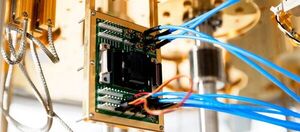
Beyond qubits: the next big step to scale up quantum computing
"Through the Microsoft partnership with the University, Professor David Reilly and colleagues have invented a device that operates at 40 times colder than deep space to directly control thousands of qubits, the building blocks of quantum technology. Scientists and engineers at the University of Sydney and Microsoft Corporation have opened the next chapter in quantum technology with the invention of a single chip that can generate control signals for thousands of qubits, the building blocks of quantum computers. “To realise the potential of quantum computing, machines will need to operate thousands if not millions of qubits,” said Professor David Reilly, a designer of the chip who holds a joint position with Microsoft and the University of Sydney. “The world’s biggest quantum computers currently operate with just 50 or so qubits,” he said. “This small scale is partly because of limits to the physical architecture that control the qubits.” “Our new chip puts an end to those limits.” The results have been published in Nature Electronics. Most quantum systems require quantum bits, or qubits, to operate at temperatures close to absolute zero (-273.15 degrees)." [...]
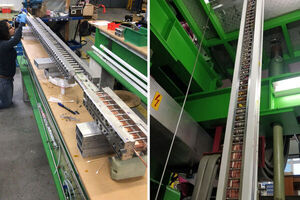
New fiber optic temperature sensing approach to keep fusion power plants running
"MIT’s Erica Salazar shows that faster detection of thermal shifts can prevent disruptive quench events in the HTS magnets used in tokamak fusion devices. The pursuit of fusion as a safe, carbon-free, always-on energy source has intensified in recent years, with a number of organizations pursuing aggressive timelines for technology demonstrations and power plant designs. New-generation superconducting magnets are a critical enabler for many of these programs, which creates growing need for sensors, controls, and other infrastructure that will allow the magnets to operate reliably in the harsh conditions of a commercial fusion power plant. A collaborative group led by Department of Nuclear Science and Engineering (NSE) doctoral student Erica Salazar recently took a step forward in this area with a promising new method for quick detection of a disruptive abnormality, quench, in powerful high-temperature superconducting (HTS) magnets. Salazar worked with NSE Assistant Professor Zach Hartwig of the MIT Plasma Science and Fusion Center (PSFC) and Michael Segal of spinout Commonwealth Fusion Systems (CFS), along with members of the Swiss CERN research center and the Robinson Research Institute (RRI) at Victoria University in New Zealand to achieve the results, which were published in the journal Superconductor Science and Technology. Stanching quench Quench occurs when part of a magnet’s coil shifts out of a superconducting state, where it has no electrical resistance, and into a normal resistive state." [...]
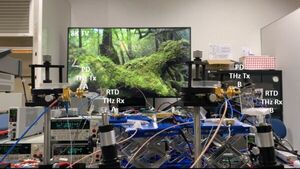
Terahertz accelerates beyond 5G towards 6G
"Researchers at Osaka University demonstrate wireless transmission of uncompressed full-resolution 8K video using terahertz waves A team of researchers at Osaka University, together with Rohm Co., Ltd., has employed 300-GHz band terahertz waves as an information carrier that allows for wireless communications of 8K ultrahigh definition (UHD) video with a data rate of 48 Gbit/s under the JST CREST project “Development of terahertz integrated technology platform through fusion of resonant tunneling diodes and photonic crystals.” The next-generation 6G mobile communication standard beyond the present 5G system is expected to transmit 8K and other UHD videos with low latency and low power consumption. Since the data rate of UHD video is very high, however, it is necessary to compress the data when being transmitted wirelessly using microwaves or millimeter waves, which results in delays and increased power consumption. Thus, the development of a technology for uncompressed wireless transmission of UHD video is required. “In general, the higher the frequency, the greater the capacity to transmit information, with terahertz waves having a higher frequency than microwaves and millimeter waves (Fig. 1). We focused on terahertz waves in the 300-GHz band,” explains Assistant Professor Julian Webber." [...]

Army researchers detect broadest frequencies ever with quantum receiver
"A new quantum sensor can analyze the full spectrum of radio frequency and real-world signals, unleashing new potentials for Soldier communications, spectrum awareness and electronic warfare. Army researchers built the quantum sensor, which can sample the radio-frequency spectrum—from zero frequency up to 20 GHz—and detect AM and FM radio, Bluetooth, Wi-Fi and other communication signals. The Rydberg sensor uses laser beams to create highly-excited Rydberg atoms directly above a microwave circuit, to boost and hone in on the portion of the spectrum being measured. The Rydberg atoms are sensitive to the circuit’s voltage, enabling the device to be used as a sensitive probe for the wide range of signals in the RF spectrum. “All previous demonstrations of Rydberg atomic sensors have only been able to sense small and specific regions of the RF spectrum, but our sensor now operates continuously over a wide frequency range for the first time,” said Dr. Kevin Cox, a researcher at the U.S. Army Combat Capabilities Development Command, now known as DEVCOM, Army Research Laboratory. “This is a really important step toward proving that quantum sensors can provide a new, and dominant, set of capabilities for our Soldiers, who are operating in an increasingly complex electro-magnetic battlespace.” The Rydberg spectrum analyzer has the potential to surpass fundamental limitations of traditional electronics in sensitivity, bandwidth and frequency range." [...]
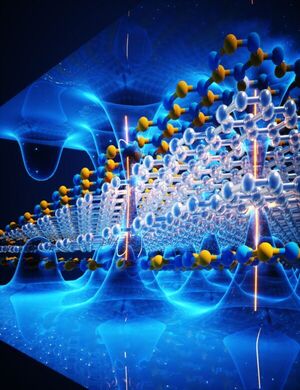
Physicists discover important new property for graphene
"MIT researchers and colleagues have discovered an important—and unexpected—electronic property of graphene, a material discovered only about 17 years ago that continues to surprise scientists with its interesting physics. The work, which involves structures composed of atomically thin layers of materials that are also biocompatible, could usher in new, faster information-processing paradigms. One potential application is in neuromorphic computing, which aims to replicate the neuronal cells in the body responsible for everything from behavior to memories. The work also introduces new physics that the researchers are excited to explore. “Graphene-based heterostructures continue to produce fascinating surprises. Our observation of unconventional ferroelectricity in this simple and ultra-thin system challenges many of the prevailing assumptions about ferroelectric systems and it may pave the way for an entire generation of new ferroelectrics materials,” says Pablo Jarillo-Herrero, the Cecil and Ida Green Professor of Physics at MIT and leader of the work, which involved a collaboration with five other MIT faculty from three departments." [...]

Stanford research could lead to injectable gels that release medicines over time
"Injecting patients with a gel that would dissolve over several months could replace the need to administer daily or weekly shots. But to make this possible, researchers first had to create a Jello-like substance that could defy one of the fundamental laws of nature. Gels are formed by mixing polymers into fluids to create gooey substances useful for everything from holding hair in place to enabling contact lenses to float over the eye. Researchers want to develop gels for healthcare applications by mixing in medicinal compounds, and giving patients injections so that the gel releases the active pharmaceutical ingredient over a period of months to avoid weekly or daily needle sticks. But standing in the way is a problem that’s as readily understood as the difference between using hair gel on a beach versus in a blizzard – heat and cold change the character of the gel. “We can make gels with the right slow-release properties at room temperature but once we injected them, body heat would rapidly dissolve them and release the medicines too quickly,” said Eric Appel, assistant professor of materials science and engineering." [...]

Transistors built from ultra-thin 2D materials take a step forward
"Two-dimensional materials can be used to create smaller, high-performance transistors traditionally made of silicon, according to Saptarshi Das, assistant professor of engineering science and mechanics (ESM) in Penn State’s College of Engineering. Das and his collaborators report in Nature Communications on tests to determine the technological viability of transistors made from 2D materials. Transistors are tiny digital switches found in cell phones, computer circuits, smart watches and the like. “We live in a digital and connected world driven by data,” Das said. “Big data requires increased storage and processing power. If you want to store or process more data, you need to utilize more and more transistors.” In other words, as modern technology continues to get more compact, so must transistors, which are considered the building blocks of computer processing." [...]

Molecule from nature provides fully recyclable polymers
"Plastics are among the most successful materials of modern times. However, they also create a huge waste problem. Scientists from the University of Groningen (The Netherlands) and the East China University of Science and Technology (ECUST) in Shanghai produced different polymers from lipoic acid, a natural molecule. These polymers are easily depolymerized under mild conditions. Some 87 percent of the monomers can be recovered in their pure form and re-used to make new polymers of virgin quality. The process is described in an article that was published in the journal Matter on 4 February." [...]

Propelling satellites into the future
"Candidate ‘green’ satellite propellants within a temperature-controlled incubator, undergoing heating as a way to simulate the speeding up of time. Today hydrazine is the most common propellant employed by thrusters aboard satellites: it is highly energetic in nature but also toxic and corrosive, as well as dangerous to handle and store. ESA initiated a study with European Astrotech Ltd in the UK to look into greener propellants and propulsion systems, to provide comparable performance with reduced toxicity and handling costs. The testing investigated the compatibility between a variety of current and future materials and weld combinations with two propellant candidates in detail while checking others as well. By using materials already present in propulsion systems, the aim is to help to reduce any necessary modifications needed, shrinking costs and development times. An eight-month test cycle became the equivalent of 5.33 years on-orbit by elevating temperature, hunting out for any degradation in the welds, materials and propellants – such as broken welds, material mass loss or etching." [...]
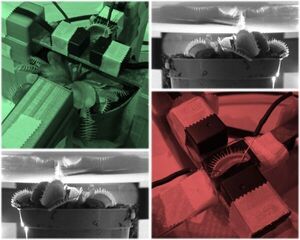
Venus flytraps found to produce magnetic fields
"Physicists use atomic magnetometers to measure the biomagnetic signals of the carnivorous plant The Venus flytrap (Dionaea muscipula) is a carnivorous plant that encloses its prey using modified leaves as a trap. During this process, electrical signals known as action potentials trigger the closure of the leaf lobes. An interdisciplinary team of scientists has now shown that these electrical signals generate measurable magnetic fields. Using atomic magnetometers, it proved possible to record this biomagnetism. "You could say the investigation is a little like performing an MRI scan in humans," said physicist Anne Fabricant. "The problem is that the magnetic signals in plants are very weak, which explains why it was extremely difficult to measure them with the help of older technologies."" [...]

Salt battery design overcomes 'bump' in the road to help electric cars go the extra mile
"Using salt as a key ingredient, Chinese and British researchers have designed a new type of rechargeable battery that could accelerate the shift to greener, electric transport on our roads. Many electric vehicles (EV) are powered by rechargeable lithium-ion batteries, but they can lose energy and power over time. Under certain conditions, such batteries can also overheat while working or charging, which can also degrade battery life and reduce miles per charge. To solve these issues, the University of Nottingham is collaborating with six scientific research institutes across China to develop an innovative and affordable energy store with the combined performance merits of a solid-oxide fuel cell and a metal-air battery. The new battery could significantly extend the range of electric vehicles, while being fully recyclable, environmentally-friendly, low-cost and safe. A solid-oxide fuel cell converts hydrogen and oxygen into electricity as a result of a chemical reaction." [...]

Tiny 3D structures enhance solar cell efficiency
"A new method for constructing special solar cells could significantly increase their efficiency. Not only are the cells made up of thin layers, they also consist of specifically arranged nanoblocks. This has been shown in a new study by an international research team led by the Martin Luther University Halle-Wittenberg (MLU), which was published in the scientific journal "Nano Letters". Commercially available solar cells are mostly made of silicon. "Based on the properties of silicon it’s not feasible to say that their efficiency can be increased indefinitely," says Dr Akash Bhatnagar, a physicist from the Centre for Innovation Competence (ZIK) "SiLi-nano" at MLU. His research team is therefore studying the so-called anomalous photovoltaic effect which occurs in certain materials." [...]
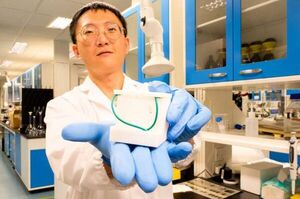
NTU Singapore team develops portable device that creates 3D images of skin in 10 minutes
"A team from Nanyang Technological University, Singapore (NTU Singapore) has developed a portable device that produces high-resolution 3D images of human skin within 10 minutes. The team said the portable skin mapping (imaging) device could be used to assess the severity of skin conditions, such as eczema and psoriasis. 3D skin mapping could be useful to clinicians, as most equipment used to assess skin conditions only provide 2D images of the skin surface. As the device also maps out the depth of the ridges and grooves of the skin at up to 2mm, it could also help with monitoring wound healing. The device presses a specially devised film onto the subject's skin to obtain an imprint of up to 5 by 5 centimetres, which is then subjected to an electric charge, generating a 3D image. The researchers designed and 3D printed a prototype of their device using polylactic acid (PLA), a biodegradable bioplastic." [...]

Solving complex physics problems at lightning speed
"A calculation so complex that it takes twenty years to complete on a powerful desktop computer can now be done in one hour on a regular laptop. Physicist Andreas Ekström at Chalmers University of Technology, together with international research colleagues, has designed a new method to calculate the properties of atomic nuclei incredibly quickly. The new approach is based on a concept called emulation, where an approximate calculation replaces a complete and more complex calculation. Although the researchers are taking a shortcut, the solution ends up almost exactly the same. It is reminiscent of algorithms from machine learning, but ultimately the researchers have designed a completely new method. It opens up even more possibilities in fundamental research in areas such as nuclear physics." [...]

Hyperchaos possibilities for modelling complex quantum systems
"Physicists have discovered a potentially game changing feature of quantum bit behaviour which would allow scientists to simulate complex quantum systems without the need for enormous computing power. For some time, the development of the next generation of quantum computer has limited by the processing speed of conventional CPUs. Even the world’s fastest supercomputers have not been powerful enough, and existing quantum computers are still too small, to be able to model moderate-sized quantum structures, such as quantum processors. However, a team of researchers from the University of Nottingham's School of Physics & Astronomy and Loughborough and Innopolis universities have now found a way to bypass the need for such massive amounts of power by harnessing the chaotic behaviour of qubits - the smallest unit of digital information. When modelling the behaviour of quantum bits (qubits) they found that when an external energy source, such as a laser or microwave signal, was used the system became more chaotic – eventually demonstrating the phenomenon known as hyperchaos. When the qubits were excited by the power source they switched states, like regular computer bits which shift between 0 and 1, but in a much more irregular and unpredictable way." [...]
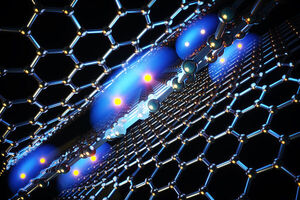
Physicists create tunable superconductivity in twisted graphene “nanosandwich”
"Structure may reveal conditions needed for high-temperature superconductivity. When two sheets of graphene are stacked atop each other at just the right angle, the layered structure morphs into an unconventional superconductor, allowing electric currents to pass through without resistance or wasted energy. This “magic-angle” transformation in bilayer graphene was observed for the first time in 2018 in the group of Pablo Jarillo-Herrero, the Cecil and Ida Green Professor of Physics at MIT. Since then, scientists have searched for other materials that can be similarly twisted into superconductivity, in the emerging field of “twistronics.” For the most part, no other twisted material has exhibited superconductivity other than the original twisted bilayer graphene, until now. In a paper appearing today in Nature, Jarillo-Herrero and his group report observing superconductivity in a sandwich of three graphene sheets, the middle layer of which is twisted at a new angle with respect to the outer layers. This new trilayer configuration exhibits superconductivity that is more robust than its bilayer counterpart." [...]
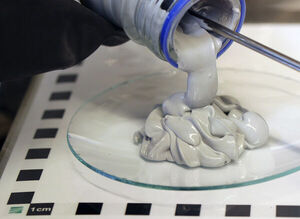
Hydrogen-powered drives for e-scooters
"Hydrogen is regarded by many as the future of propulsion technology. The first hydrogen-powered cars are already in action on German roads. In the case of e-scooters, however, installation of a high-pressure tank to store the hydrogen is impractical. An alternative here is POWERPASTE. This provides a safe way of storing hydrogen in a chemical form that is easy to transport and replenish without the need for an expensive network of filling stations. This new paste is based on magnesium hydride and was developed by a research team at the Fraunhofer Institute for Manufacturing Technology and Advanced Materials IFAM in Dresden." [...]

An optical coating like no other
"A ‘FROC’ can both transmit and reflect the same color simultaneously, a breakthrough in optical coating. For more than a century, optical coatings have been used to better reflect certain wavelengths of light from lenses and other devices or, conversely, to better transmit certain wavelengths through them. For example, the coatings on tinted eyeglasses reflect, or “block out,” harmful blue light and ultraviolet rays. But until now, no optical coating had ever been developed that could simultaneously reflect and transmit the same wavelength, or color. In a paper in Nature Nanotechnology, researchers at the University of Rochester and Case Western Reserve University describe a new class of optical coatings, so-called Fano Resonance Optical Coatings (FROCs), that can be used on filters to reflect and transmit colors of remarkable purity. In addition, the coating can be made to fully reflect only a very narrow wavelength range." [...]
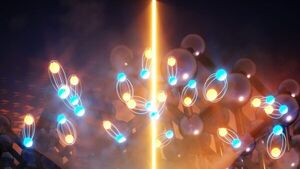
Switching Nanolight On and Off
"Columbia researchers discover a new way to program light on an ultra-small scale. A team of researchers led by Columbia University has developed a unique platform to program a layered crystal, producing imaging capabilities beyond common limits on demand. The discovery is an important step toward control of nanolight, which is light that can access the smallest length scales imaginable. The work also provides insights for the field of optical quantum information processing, which aims to solve difficult problems in computing and communications. “We were able to use ultrafast nano-scale microscopy to discover a new way to control our crystals with light, turning elusive photonic properties on and off at will,” said Aaron Sternbach, postdoctoral researcher at Columbia who is lead investigator on the study. “The effects are short-lived, only lasting for trillionths of one second, yet we are now able to observe these phenomena clearly.” The research appears Feb. 4 in the journal Science." [...]
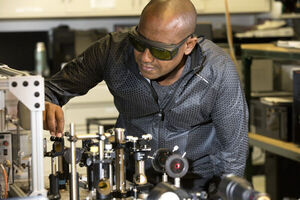
Imaging technique provides link to innovative products
"The process moves researchers step closer to using the materials in applications When we think about the links to the future – the global transition to solar and wind energy, tactile virtual reality or synthetic neurons – there’s no shortage of big ideas. It’s the materials to execute the big ideas – the ability to manufacture the lithium-ion batteries, opto-electronics and hydrogen fuel cells – that stand between concept and reality. Enter two-dimensional materials, the latest step in innovation. Consisting of a single layer of atoms, two-dimensional materials like graphene and phosphorene exhibit new properties with far-reaching potential. With a capability to be combined like Lego bricks, these materials offer connections to future products, including new means to convey both power and people, with more-efficient energy transmission, and solar- and wind-powered vehicles on roads and in skies. A study led by University of Georgia researchers announces the successful use of a new nanoimaging technique that will allow researchers to test and identify these materials in a comprehensive way at the nanoscale for the first time." [...]

Chemists create and capture 'einsteinium' — the elusive 99th element discovered among the debris of the first hydrogen bomb
"Einsteinium, the elusive 99th element on the periodic table, has been created and captured, allowing some of its properties to be characterised for the first time. Not naturally occurring on Earth, the so-called 'synthetic element' was discovered among the debris of the first hydrogen bomb in 1952. Since then, very few experiments have been undertaken with einsteinium, because it is exceptionally radioactive and extremely difficult to produce. Researchers from the US, however, have used cutting-edge technology to create 250 nanograms of the element. This basic property determines how einsteinium will bind with other atoms and molecules and is key to understanding the kinds of chemical interactions it can have. 'There's not much known about einsteinium,' said paper author and heavy element chemist Rebecca Abergel of the Lawrence Berkeley National Laboratory in California." [...]
Projetos Maker
Diversos Projetos interessantes.
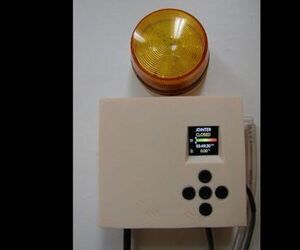
Dust Collector Monitor
"This is a dust collector monitor. Both the dust bin level and the filter are monitored. My earlier dust collector project only monitored the bin level. The video demonstrates the dust collector monitor detecting the filter needing cleaning. The threshold was set low to force this to happen for the video. Normally on my dust collector the filter would be considered loaded after the duct pressure passes 3" of water or 7.5hPa." [...]

Make a Face Mask With Animations
"Let's make a Face Mask with LEDs! This DIY LED lights face mask displays some animations and responds to your voice with effects. You can have a mask that reacts to the sound using the sound sensor, or you can make different light animations by not activating the sensor. I have an addressable LED. What that really means it's just that in a normal LED strip when you power it all the LEDs light up at the same time. But an addressable LED powers up based on what you input to it from a microcontroller and you can tell LED number one to light up in one color and LED number ten to light up in another color." [...]
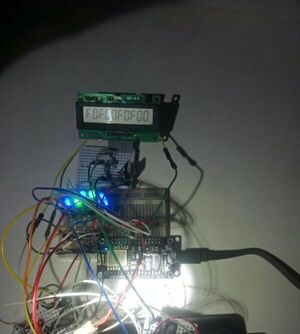
10 Channel Wi-Fi Switch for Smart Home
"This device can help you automate your home, backyard, or whatever you want. To build this device, you'll need: ESP8266 x1; 4-stage ripple (binary) counter (I can suggest SN74LS93N) x1; 14-stage ripple counter (CD4020BE is the best choice) x1; Latches (SN74LS75) x6. Since each SN74LS75 consists of 4 latches, only 2 ICs are needed; LEDs x10; 470 ohm resistors x10; 10k resistor x1; 20k resistors x2; 33k resistors x2; 50k resistor x1; LM317 x1; ULN2003 x2; Relays x10; Power supply for ESP x1; Power supply for relays. Note: You can use CD4024B Instead of CD4020BE and SN74LS93N. " [...]

1Khz to 20Mhz Low Power Oscillator
"This is a precision, low power oscillator that occupies very little space. The oscillator frequency is adjustable using an onboard multi-turn trimmer potentiometer. The output of the circuit is very accurate and has a 1.5% frequency error. The project operates with a single 5V power supply and provides a rail-to-rail, 50% duty cycle square wave output. The CMOS output driver of the chip ensures fast rise/fall times and rail-to-rail switching. A multi-turn trimmer provided to adjust the master oscillator frequency between 1Khz to 20Mhz." [...]
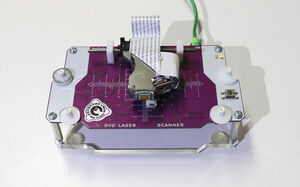
DVD Laser Scanner Microscope
"The laser scanning microscope is a special light microscope which uses a focused laser beam to scans the sample. The scanning of the laser across the sample is done by driving the laser in x and y direction. The image is composed in the software by combining the measured light points. The DVD Laser Scanner Microscope is build from two DVD pick-up heads. The laser of the DVD head is used to illuminate the sample at a tiny spot, focused with the DVD heads own focusing mechanism. The deviation of the laser is done by the pick-up heads lens moving coils." [...]
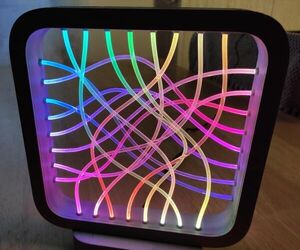
Fiber Optic LED Lamp
"This LED lamp is in a way a continuation of my previous project "Fiber Optic and LEDs - a Wall Decoration", I think a natural one, I wanted to make something simpler, easier to do, that would be available to many of you. The "mechanical" parts of the lamp are 3D printed, the electronic part is simple and the plastic optical fiber is eye catching. The shape of the lamp is inspired by Helder Santos' project "Square LED Lamp" and the arrangement of the optical fibers is very similar to that of my project mentioned above. I will show you in this instructable how easy it is to make this LED lamp. " [...]
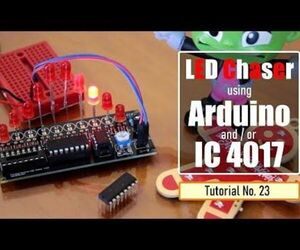
LED Chaser Circuits Using IC4017 and Arduino
"A Chaser Circuit consists of a clocked IC or other electronic unit like an Arduino that drives an array of LEDs in such a way that individual LEDs (or small groups of LEDs) turn on and off in a predetermined and repeating sequence, thus producing a visually attractive display in which one or more ripples of light seem to repeatedly run through a chain or around a ring of LEDs. In this tutorial I am going to create 3 chaser circuits using Arduino and IC4017 decade counter. Lets first create the chaser circuit using the IC4017 decade counter and IC555 timer IC. For the Non-Arduino bit we need: 2 x 4017 Decade Counter IC 1 x 555 Timer IC 1 x 10 K Potentiometer 1 x 1 Kilo Ohm Resistor 1 x 100 Ohm Resistor 1 x 100 MFD Capacitor 20 x Zener Diodes and 10 x Red LEDs The circuit is very simple. The 555 Timer IC operates as a clock oscillator or clock generator. The output on PIN-3 goes high causing a shift." [...]
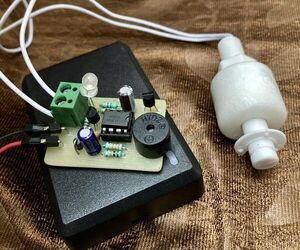
Save Water With Over Flow Alarm
"Water plays an important role in our day-to-day life. Although our mother earth is covered with 71% of the water we have just very little; that is approximately only 1.2% which is available for domestic usage. As we being.. human beings It is our mutual responsibility to save water by at least taking small steps in our daily life, like not over-consuming water and prevent the excess usage, also we can take a small step towards preventing overflow of the water from the water tank which gets wasted. Such a life-supporting and a life saving but ultimately a finite resource gets wasted due to our negligence. Here we can take a small step towards prevention of overflow of water from the water tank; Presenting here a “low-cost overflow alarm” which is made from very few electronic components like IC 555, Some resistors and capacitors, etc. Here IC 555 is configured in Astable multivibrator mode." [...]
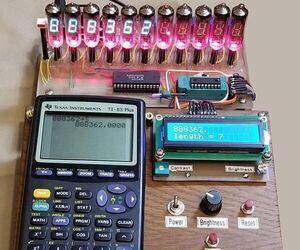
VFD Display for the TI83+ Calculator
"This project builds upon the PIC/TI83+ interface developed by ThomasHenry (see Nuts & Volts August 2013 A Mathematics Engine for Microcontrollers). Acknowledgment, appreciation, and kudos to him for writing the TI-library for Great Cow Basic that made this project possible. When I recently re-discovered that article, I imagined re-creating the only calculator that was available on campus when I was a Freshman in college. That calculator was in the basement of the Chemistry building, and students had to wait in line to get their 10 minutes on the beast, which displayed results on several large nixie tubes. My version uses VFDs, is much smaller, but still is reminiscent of that unit. In short, this project will display calculator values or results on both an LCD and 11 VFD tubes." [...]
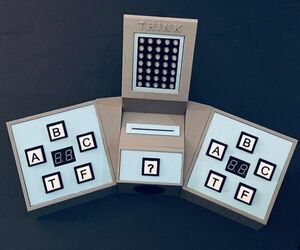
Think-a-Tron 2020
"In 1960, Hasbro unleashed its first personal "computer" to the masses. Called Think-a-Tron, it was launched decades ahead of IMSAI, Apple, or Commodore machines. Ok, my opening paragraph for this Instructable is just a "bit" overstated, but so was the marketing for Think-a-Tron, "the machine that thinks like a man". While some toys of the same era, like the Digi-Comp I for instance, endeavored to teach people about computers, Think-a-Tron took advantage of the growing interest in computers to sell a cleverly packaged trivia game. In fact, if there is any "claim to fame" attached to Think-a-Tron, it's that it introduced the trivia game concept 21 or more years before Trivial Pursuit. My goal for this project was to honor Think-a-Tron, not to reproduce it." [...]

Circuit Board for Making Freeform Circuit Sculptures
"Intro: I find that working as an electrical engineer in a professional environment causes you to think about electrical design differently than you might in the makerspace. You learn how to do simple designs really quickly, but also have to consider a number of variables you wouldn't need to when just doing it for fun, such as signal integrity, accuracy of voltages, and the list goes on and on. I've been looking for ways to get more creative in personal engineering projects, and recently discovered the art of freeform circuit sculptures. This artform is actually a little difficult to get into if you haven't tried, so I decided to make a platform for lighting some LEDs to start with while I improve my ability to solder brass and copper wires. Supplies: Equipment: - Soldering Iron - Solder - File (to file down the brass wires) Parts (Per Board): 8x - 22uF capacitors (can be larger) 7x - Transistors (2N3904 is fine) 7x - 33kOhm resistors (can be changed based on capacitor) 7x - 220Ohm resistors 1x - Button Battery Cell Clip 1x - On/Off Switch For the Sculptures: 7x - 5mm LEDs - Brass wire or copper wire" [...]
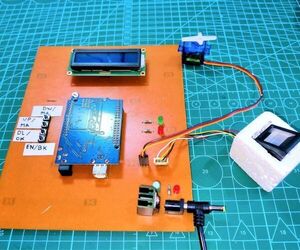
Biometric Door Lock Security System Using Arduino & Fingerprint Sensor
"Hey Friends welcome to Techno-E-solution In this tutorial, Ill show you how to make Biometric Door Lock Security System Using Arduino Uno & Fingerprint Sensor R307. The Biometric security system is designed using Arduino uno & fingerprint sensor R307 where once the correct finger ID is placed, the door will get open and concerned person is allow access to enter. Biometric security system use Arduino Uno as a microcontroller where a finger ID will act as a door unlocking system or a key. we made a Biometric locks system using Arduino Uno, which provides control to the door locking system which is servomotor. It is a simple system with take input from finger print sensor and the output give command to servo motor to lock/unlock. The system provides you to delete the finger id using setting buttons." [...]

Extending GPIOs of ESP8266-01 and IoT || Exploring ESP8266:Part 3
"Hello all! This instructable happens to be part 3 of my ESP series where I continue to experiment and explore the various features of the ESP 8266-01 board. In the first and second part of the series I have mentioned the wonderful capability of this little board to support I2C communication and also interfaced the ESP board with multiple I2C devices. You can read more about these features in the previous parts: Part 1: https://www.instructables.com/I2C-With-the-ESP8266... Part 2: https://www.instructables.com/ESP8266-01-With-Mult... In this part of the series, we will look at the possibility of extending the GPIO pins of the ESP8266 and also control the pins using IoT! For IoT integration we will be using the Blynk application which is quite simple to integrate with IoT projects." [...]

Mechanical 7 Segment Display V2
"Hello and welcome back to another Instructable. In the previous two Instructables, I have shown you how I created PCB coils in Kicad using a Python script, covered the basics of an H bridge, and showed you how I will be using them to control the segments of the 7-segment mechanical display. Make sure you check those out. My aim is to replace the huge electromagnets in the Mechanical 7-segment Display with the PCB coils. In this Instructable, I will combine the 7 coils and the H bridge drivers on a single PCB to create a working 7 segment display. Lets get started!" [...]
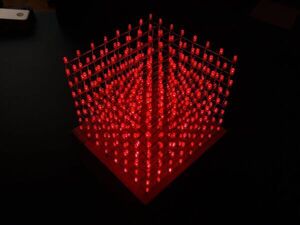
LED Cube 8x8x8
"LED Cube running on Arduino Nano and flip-flops. Preparation: test all 512 LEDs (and additional 50 spare ones if some get damaged while soldering) to find all the malfunctioning ones. Let them run for at least 4 hours. make symmetrical holes in a wooden/plastic box and place the LEDs there to make a 8x8 grid. " [...]

PICO Arducam Examples
"See Getting Started with the Raspberry Pi Pico and the README in the pico-sdk for information on getting up and running. Quick Pico Setup If you are developing for Raspberry Pi Pico on the Raspberry Pi 4B, or the Raspberry Pi 400, most of the installation steps in this Getting Started guide can be skipped by running the setup script. You can get this script by doing the following: git clone https://github.com/raspberrypi/pico-setup.git Then run: pico-setup/pico_setup.sh The script will: Create a directory called pico Install required dependencies Download the pico-sdk, pico-examples, pico-extras, and pico-playground repositories Define PICO_SDK_PATH, PICO_EXAMPLES_PATH, PICO_EXTRAS_PATH, and PICO_PLAYGROUND_PATH in your ~/.bashrc Build the blink and hello_world examples in pico-examples/build/blink and pico-examples/build/hello_world Download and build picotool (see Appendix B). Copy it to /usr/local/bin. • Download and build picoprobe (see Appendix A). Download and compile OpenOCD (for debug support) Download and install Visual Studio Code Install the required Visual Studio Code extensions (see Chapter 6 for more details) Configure the Raspberry Pi UART for use with Raspberry Pi Pico Once it has run, you will need to reboot your Raspberry Pi," [...]

Ultrasonic Levitation Experiment
"The basic operating principle is to set up an acoustic standing wave. Acoustic levitation is a method for suspending matter in air against gravity using acoustic radiation pressure from high intensity sound waves. Presented device is based on an acoustic transducer and a reflector. The main component of the levitator is the transducer, element that transform the electrical input signal into ultrasonic acoustic waves. In this case, this is 60W transduser with resonant frequency of 40 KHz which I bought for about 15 Dollars. Levitator is driven with a sinusoidal excitation signal to generate a standing wave between his elements; this standing wave will trap particles at its nodes." [...]

LauraBox
"A children's juke box controlled by RFID tags, based on an ESP32. Features: - Playback of user-defined MP3 playlists - Playlist selected though RFID tag. Cheap RFID stickers can be placed on any 3D printed model. - Battery powered, can play while charging - Four buttons: volume +/-, next/previous track - Intuitive pause functionality by removing the RFID tag and putting it back on to resume (no limit in pause time, no impact on battery life) - WiFi download of new MP3s and playlists - Firmware upgrade via WiFi - Long standby time (several month) - Long play time (many hours, if not days) - Toddler proof :-) Main components - EPS32 microcontroller - MFRC522 RFID board - PCM5102 I2S stereo audio DAC - PAM8403 stereo amplifier - Pair of wideband speakers - 3.6V Li-ion battery with USB charge controller from a USB power bank (2x 18650-type cells with 2500 mAh) - SD card to store MP3 files and playlists Why use the ESP32? At first I was considering building the box based on a Raspberry Pi. I had an old first generation Pi lying around unused, so I though it would be a good way of using it." [...]
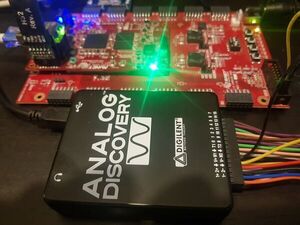
Signal Processing with XADC and PYNQ
"Creating a PYNQ image for the MicroZed 7010/20 and IO Carrier Card. Signal processing with XADC. Introduction We are all familiar with the RFSoC and the high speed ADC and DAC which are combine with the ZYNQ MPSoC. However, you might not be aware all Xilinx Seven Series and up have a XADC / Sysmon ADC which is cable of monitoring the internal voltage rails and die temperature. the XADC / Sysmon is also capable of monitoring external analog signals, ont eh Zynq 7000 it is able to sample at up to 1 MSPS which makes it very interesting for simple signal processing applications. I have also seen few applications which use PYNQ to capture data from the XADC so in this project we are going to create a simple XADC scope application." [...]
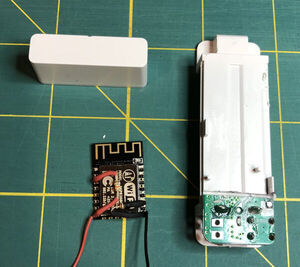
ESP8266 Window Sensor with OTA and Deep Sleep
"I was looking to boost my home security by adding window sensors. Something small and obscure so it would not stand out. I landed on this axGear sensor unit. It is small (70 mm x 20 mm). However, there was only one problem – it comes with proprietary software that I’m not sure I can trust. I also intended to integrate it with the ecosystem of devices I’ve created which I manage using Blynk." [...]
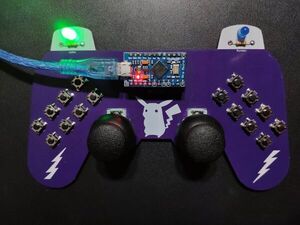
Arduino-Based (ATmega32U4) Mouse and Keyboard Controller
"This Raspberry Pi-compatible device lets you use joysticks as a mouse and enter keyboard and modifier keys with two dynamic keypad options. For a long time, I needed a simple device allowing me to send varying mouse and keyboard commands to test some of my web applications and games on browsers. Also, I could utilize such a device to test keyboard and mouse functionalities of new single-board computers, for instance, Raspberry Pi, without kvetching about my lack of a proper keyboard and mouse :) Thus, I decided to create this project. First of all, to be able to send keyboard and mouse commands via USB, I used an Arduino Pro Micro centered around an ATmega32U4 - an 8-bit AVR very similar to the ATmega328. The ATmega32U4 comes equipped with a full-speed USB transceiver, which can emulate any USB device. Then, I utilized the 4x4 matrix keypad design to send keyboard keys, supporting up to 32 keys with two dynamic keypad options." [...]
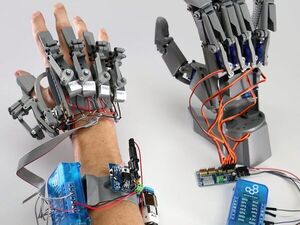
YouBionic Robot + Exo Hands
"The Robot and wearable Exo Hands are two projects that implement a wearable glove that allows you to control the movements of the Robot Hand Gather all hardware components listed above and follow the Ubionic Robot Hand and Exo Hand manuals to assemble the components. To wire the Robot and Exo hand servos and potentiometers to the Builder Bases follow the diagrams and schematics below. To wire the Robot hand servos: First Connect the the SDA, SCL, GND, 5V, and 3.3V ports to PCA9685 as shown. Next, connect the PCA9685 to the servos as shown. " [...]

Building Your Own Laser Engraving Machine with Arduino
"Who doesn't love a bit of laser engraving? Unfortunately, most of us need to hire the services of a professional to get the job done. Thankfully, with this great little DIY project, you can make your own out of some common electrical components, some old DVD writers, and some 3D printed parts! ike any project of this nature, you are going to need a few bits and bobs. For this build, you will need: Arduino Nano 2 no. old DVD writers (you want the stepper mechanisms within) 4 no." [...]
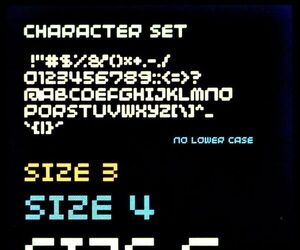
Raspberry Pi Pico & Pico Explorer Workout
"In this Instructable I'm going to demonstrate the new Raspberry Pi PICO microcontroller board for Physical Computing and Graphics using the Pimoroni PICO EXPLORER. I am going to assume that you have installed the Pimoroni UF2 file to your Pico, installed the Thonny Editor on your computer, know how to connect your Pico to your computer's USB port, enter and run code from Thonny. Pimoroni have supplied a few graphics commands - screen clear, filled rectangles and circles, pen colours, pixel, text string and text character printing to the screen. This demonstration adds lines, hollow rectangles and circles, bar and line graphs, user defined characters and how to combine them in various ways to scroll text cross the screen and react to physical changes as buttons are pressed and a potentiometer knob is turned. I hope you will find it useful. Supplies: Raspberry Pi PICO Pimoroni Pico Explorer and associated UF2 file Suitable USB lead 10K Ohm potentiometer LED 470 Ohm resistor Jumper wires Thonny Editor" [...]
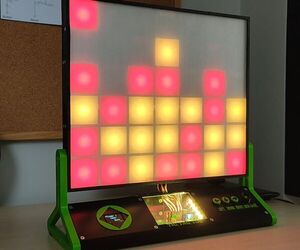
Tic-Tac-Toe
"Hello guys, I would like to share with you my last project. Tic-Tac-Toe Game. This game is for only two people/players. They are trying to place four squares of their color next to each other. These four squares can put in a row, column, or diagonal. Supplies: Components: 1x Binary switch 1x DC Jack 5,5mm/2,1mm ?x Wires (signal/servo) 1x OLED 128x64 pixel display 7x Neopixel 6 LED strips 7x Pinhead female 3x1 MAIN PCB: Arduinos: 2x ATMEGA 328P-AU 2x Quartz crystals 2x Capacitors 100n 0805 2x Capacitors 22p 0805 2x Resistor 1k 1206 2x Chip LED green 0604 ICSPs: 2x Pinhead male 6x1 2x Resistor 1k 1206 2x Chip LED red 0604 LED Array: 3x Pinhead male 7x1 2x Capacitor 1000uF 7x Resistor 220R 1206 Communication: 4x Transistor BC547 8x Resistor 220R 1206 Supply: 1x PCB Terminal block BUTTON PCB: 4x TACT Microswitches 4x Resistor 10k 1206 1x Pinhead male 6x1" [...]

MIDI Drum Machine
"A drum machine is a musical instrument which plays sequences and patterns. Usually drum machines produce percussion sounds, drum beats, etc. but this one has a built-in MIDI synthesiser, amplifier and speakers so it can produce "melodic" as well as percussive sounds. It allows you to program your own rhythms and beats. You can also attach pads that allow you to play drum sounds "live", either on top of a programmed drum beat or as a standalone performance. The musical notes are produced by a MIDI chip - the VS1053 - which has 166 voices (i.e." [...]
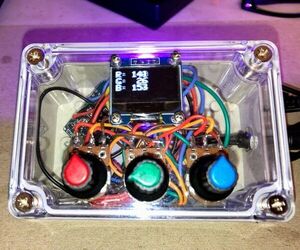
Remote Color Picker for House LEDs
"I wanted to get just the right color on my house LEDs to emulate the warm color of patio lights. So, I built a remote control that has knobs for the red, green, and blue colors and an OLED display to show the RGB values. It connects via WiFi (mesh) to the house LEDs, so I can see them live while standing in the yard. The ESP8266 modules allow the WiFi connection, and I was using them already for the house LEDs since they need more RAM than an Arduino offers. I have a web site controlling the house LEDs for some holidays, and I have used app based control setups like Blynk, but the visceral feel of turning a knob while watching the colors change is really nice. I made a push button color picker before, and the potentiometers are easier to use." [...]
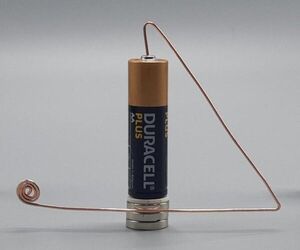
Homopolar Motor
"In this Instructable I show you how to make a simple homopolar motor. In the previous YouTube project I made a Maglev train. For this I purchased a number of Neodymium magnets. While searching for what else is possible with these magnets, I came across a number of homopolar motors. They are often very simple but I continue to find them fascinating to see. How it works: The homopolar motor is driven by the Lorentz force." [...]
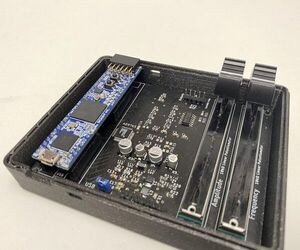
The Process of Designing and Ordering a PCB- Signal Generator Using FPGA
"As an electrical engineering student, we had a class in the 5th semester that was entirely evaluated on a project done in less than 2.5 months. This project was a Direct Digital Synthesizer (DDS) based on a Field Programmable Gate Array (FPGA). After brainstorming the idea was to make a device that synthesizes signals (Sinus, Cosine, Triangle, Saw-tooth, Rectangular and Noise). The frequency range should be between 1Hz and 1MHz, and the whole system should be based on FPGA (Read more about it here and why an FPGA is super cool). The FPGA was programmed in VHDL- a hardware description language using Xilinx software. The FPGA should have a block memory or a BRAM that has the values of each signal to be synthesized or what is known as a look up table (LUT)." [...]
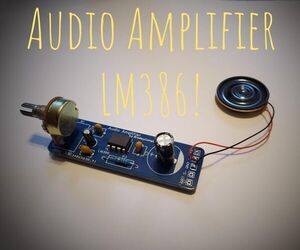
Audio Amplifier With the LM386!
"Hello everyone, today I'm going to show you how to make a simple audio amplifier with the very popular LM386. The hunt for an audio amplifier began when I wanted to spice up my Arduino projects with audio, but realized there was no easy method. This is how I was introduced to the bodacious LM386. The LM386 is capable of driving a vast array of speakers, and is very suitable for microcontrollers such as Arduino UNO or RaspberryPi. Let's go!!! Supplies: LM386 B10K Pot." [...]
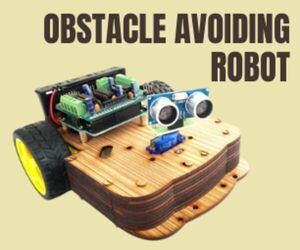
How to Make Smart Obstacle Avoiding Robot Using Arduino Uno
"Hi guys. In this instructable, I will teach you how to build an obstacle avoiding robot. The robot will be a small and simple 2-wheeled car which will move forward until it detects an obstacle in its path. Upon doing so, it will stop, move a little back and then look towards its left and right. Then it will compare the distances available ahead on either side and then turn towards the direction where the distance available seems to be more relatively. This way it will be able to move in an environment full of obstacles without colliding with any." [...]
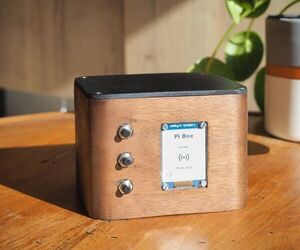
Home Buddy: Network Ad Blocker & Weather Station
"Hi Folks! Aren't you fed up with web tracking and "personalized" ads ? Well... I am, so a few months ago, I decided to act. Fortunately, some people (who probably felt the same as me), hard coded a brilliant software to eradicate ads (thumbs up to Pi-hole). I won't go into details regarding Pi-hole ins and outs as the subject has already been thoroughly documented by others." [...]
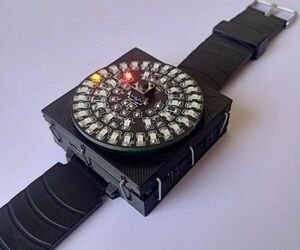
Analog As Well As Digital Watch
"Recently I had thought of making a DIY wrist watch but didnt worked upon it until now. What interesting about this wrist watch is that it is digital but actually analog, what I mean to say is time will be shown by LEDs but the way LEDs are arranged makes it look like more analog. The plan is to arranged LEDs in circular format so that every number can be indicated by LEDs, to keep it simple only hours and minutes will be shown and not seconds. So, 12 for hour and 30 for minutes (I will address this in a while) having 42 LEDs on a circular area of diameter 45mm is not a joke and and even 3mm LEDs cannot fit, many smaller SMD package are available but I decided to go with 1206 package as these can be easily soldered by hand. I opted for hand soldering so that the project can be made by any other who wants with minimal tools and materials. For soldering SMD components you have to buy solder paste, a hot air gun or hot plate iron which simply increases the cost to project How are we going to drive 42 LEDs ??" [...]
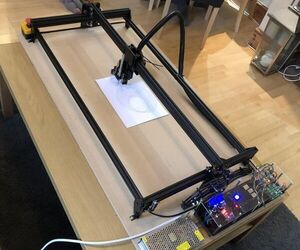
ACRO Openbuilds Pen Plotter (Arduino With GRBL and Raspberry Pi With Universal G Code Sender)
"I have had an interest in building a CNC machine for quite a while but having lived in small flats/apartments there have always been barriers whether it be space, noise or dust! This instructable details my build of a CNC plotter using an OpenBuilds ACRO system frame. I have not covered every single step however I hope it gives an idea of the process, some resources that I found helpful and also what can be achieved! A summary of the CNC tool chain is shown and this instructable will cover: The ACRO Frame The Z axis Arduino and CNC Shield with GRBL Power: On/Off switches and E-Stop Limit switches Headless Raspberry Pi with Universal G Code sender Connections and calibration Future improvements The supplies I used will be documented at the start of each section. As well as these I have used the following equipment and some standard electronics supplies including: Screwdriver set (flat head and Phillips head) Needle nose pliers Wire cutter and strippers Ruler 2.45mm crimping set Single and Multi core wire (various colours) Soldering iron" [...]
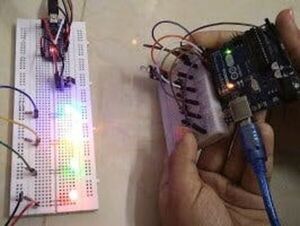
DIY IR Remote and IR Remote controlled LEDs
"Make your own DIY IR Remote and control some LEDs with it In this project documentation, you will be reading about making a DIY IR Remote and controlling LEDs with it. For this project, you will be needing both Arduino Uno and Arduino Nano. Before starting this project, make sure that you install the IRremote Library by Ken Shirriff from your Arduino IDE software. Please visit this website, to learn about IR communication in detail. Refer to the 'Coding' section in this page to understand how to start this project. " [...]
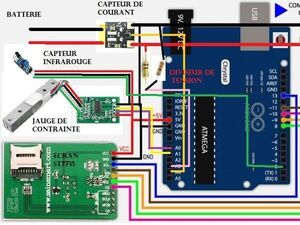
Thrust Stand and Power Analyser low cost
"The commercial existing Thrust Stand and Power Analyser is very expensive, I tried to make one at low cost, less than 30€. The existing motor tests benchs, thrust and power analyzer, are very expensive, I tried to make one at low cost, less than 30 € In addition I created an Android application for the real-time display of the parameters: Battery voltage Rotation Speed Thrust Amperage Power I also wanted to make a simple fixing system allowing to test the various brushless motors or Electric Ducted Fan (EDF) with fast assembly and disassembly. The test bench allows easy use of ESCs of different powers in order to adapt to the motors to be tested. With this test bench you can choose your engine / propeller / ESC or EDF / ESC torque according to the characteristics of the aircraft you are building and check that the choice made will allow the aircraft to fly, you need a weight / traction power ratio greater than 1 and even 1.5. The created application saves the data for storage and for later analysis and the results" [...]

An Electrician's Wingman
"Augmenting electrical safety through Ada Coverstory ELECTROCUTION Worker dies after being electrocuted (a worker, 20, died after reportedly being electrocuted by a cable from a park lamp, where the victim was welding a gate - he was taken to a Hospital, but died on the way - the park lamp pole did not have a lamp, but the cable was cut open and touched the victim) ELECTROCUTION Worker electrocuted at Pretium plant (worker died of an electrocution at a bottle molder - he was an outside contractor working on an air compressor - he touched a live connection inside a control panel - he was treated at the scene, but pronounced dead at a Hospital) ELECTROCUTION Worker Fixing Leak Dies After Hit Power Line (a worker, in his early 30s, fixing an underground leak was killed when he hit an underground power line - doctors were not able to revive the worker - he suffered cardiac arrest after making contact with the underground power line - fire officials say they pulled the victim out of the hole where he was doing repair work to some sort of leak - he was not conscious) (Source: Some of the few mentioned Electrical Accidents archived) In the realm of personal protective equipment, protective gloves offer the first line of defense against an array of hazards. Most often, they are used to protect the hands against scrapes, cuts, chemical, biological, and electrical hazards--with the goal of avoiding or limiting damage to the fingers, hands, wrists, and lower arms. While industry giants like Honeywell are on the verge of designing Advanced Electrical Safety Gloves based on RFID technology, still there exists much scope for developing on low-cost, open-tech in terms of affordability and simplicity that can be re-tailored as per end user's need. Ada Environment One fact that an "average joe" discovers while searching for Ada Language, is it's root bindings with DoD (as a great initiative for improving on software engineering practices in the early 1970s. When Ada was first defined, it was ahead of its time. It had ambitious requirements and introduced many features — e.g., packages, exceptions, generics, tasking — that were not used in mainstream languages." [...]
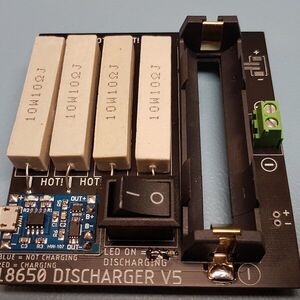
18650 Discharger
"A self powered 18650 Lithium-Ion battery discharge board. When I designed and tested a Li-ion charging circuit I needed a discharged Li-ion cell and so I grabbed a few power resistors and from time to time I measured the voltage because I did not want to discharge it to deep, otherwise the battery may get damaged. But the risk is high that one day I forget it completely. I needed a simple self powered discharge tool, not an electronic load that requires setting up from a computer or something. In this project I am designing a simple and cheap 18650 battery discharge tool that discharges until 2.45V and then releases the load so that the voltage can recover to about 2.85V. The smart thing is that I use super cheap DW01 and FS8205 li-ion protection circuit that is present in so many battery protection boards to do the voltage cut out and release." [...]

How to type on LCD using Bluetooth
"I made a very simple project just using Arduino Nano to connect LCD 16x2 screen with Bluetooth module to display letters using Andriod app. I have created a simple and a fun project with a Nano, LCD and Bluetooth Module.I have been working on this project for almost 2-3 hours on 31 January, 2021. To do this project, you have to go to play store to install the smart Bluetooth app on any android device. If you have to type something on the LCD screen, you have to click the setting on the top right corner on the smart bluetooth app.Then, a drop down box will appear.Click the terminal option of the settings.Then type whatever you want.You can also type your full name.To delete the sentence, backspace the whole sentence and then type the '-' symbol on the android to delete single letter. " [...]

Fall detection and heart rate monitoring using AVR-IoT
"A wearable low-powered device detects falls using machine learning at the edge. It also monitors the heart rate. Overview Falls can result in physical and psychological trauma, especially for the elderly. In order to improve the quality of life of these patients this project presents the development of a fall detection and heart rate monitoring system. The wearable device obtains information from accelerometer and heart rate sensor and sends them to the AWS IoT Core. The fall detection is done offline on the chip using a machine learning algorithm." [...]
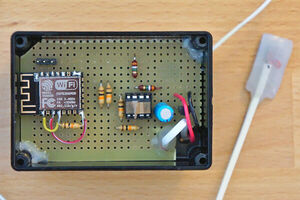
ESPmeter
"ESPmeter helps monitoring domestic gas consumption; a small device captures data from the gas meter which is then sent to a server via HTTP; a web application allows visualizing daily gas consumption with a granularity up to 5 minutes. Operating principle For this device to work, we need a type of mechanical gas meter having a magnet installed on one of the digits of its counter. A probe equipped with a Hall effect sensor is placed near or on top of the counter; the digit revolves when the gas flows and so does the magnet which becomes periodicaly detectable by the sensor. Keeping track of revolutions over time allows to calculate the amount of gas consumed during a certain period. While this project has been designed with gas meters in mind, it could theoretically work with other meters, such as water meters, as long as they have a detectable magnet moving along one of the indicators. Design The device has been designed to be extremely easy to build, using a small number of very common components." [...]
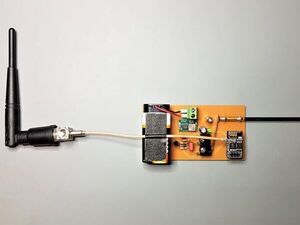
IoT mailbox guard
"Receive an e-mail when your good ol' mailbox is opened? No problem with this low-power IoT mailbox guard, using the cheap ESP-01S module! Story From now on I will receive an email when the flap of my mailbox has been opened. For this I use the inexpensive ESP-01S module, which can dial into the WLAN and send e-mails. The battery-operated module is simply stuck in the appropriate position in the mailbox. " [...]
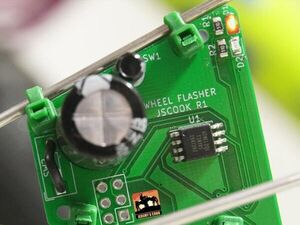
Bike Wheel Light PCB
"Board straps to bicycle spokes, lights up when you start moving! Story Riding a bicycle at night can be dangerous. Having lights on your bike can help, even better if they come on automatically! Supplies: PCB - KiCAD project available on GitHub, PCBs produced by NextPCB ATtiny85-20SU [eBay] Low Sensitivity Vibration Sensor 0805 resistors (4) a sample book can be extremely useful 0805 LEDs (4) [Amazon] CR2032 Battery CR2032 Battery holder - as seen in video, had a hard time with either one Solder paste [Amazon] DIP switch (1 position - optional, can use wire instead) Capacitor (2200uF used, could likely go smaller) Zip ties (4)" [...]
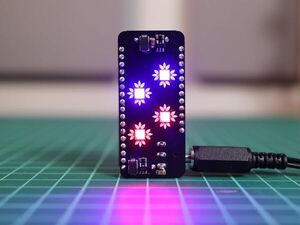
Grow Light Feather Wing
"A minimalist grow light that is compatible with the Adafruit Feather Huzzah dev board. One of my previous projects was a hydroponic system for growing strawberries, for which I used a grow light from IKEA. But one thing I didn't consider while building it was that plants, just like humans, need breaks too. Light-dark cycles are very important for plants, and constant light exposure may actually harm them. Also, the plant's light needs vary depending on the type of plant or its growing stage. For example, red light is more important for the flowering & fruit production stage, while blue light is important for strong stems and leaves." [...]
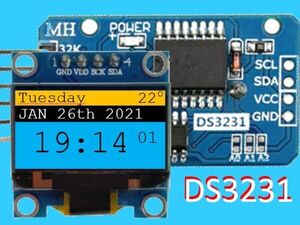
Tutorial on how to use DS3231 RTC Module
"Build a cool looking clock using RTC3231 and DS1306 OLED display In this tutorial I will show you how to use DS3231 RTC module. It will explain how I2C connectivity works. Also I will show you how to create a digital clock that reads date and time from DS3231 and displays it in thice graphical format on the OLED display. Hope that you will find this video useful. " [...]
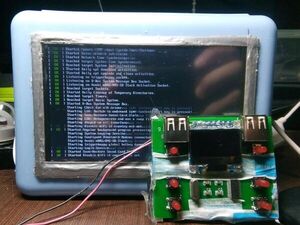
Raspberry Pi - POCKET DATA TRANSFERER
"Transfer Data Between any USB_STORAGE_MEDIA devices. I started to develop this project when I was in my 11th grade, as being from a very small town of India (Sambalpur my town) it was hard to gather sufficient information required to build an electronic device and how to program it. Although the internet helped a lot and somehow I was able to build a very low-quality prototype. I and my team thought to make a fully working MVP(Minimum Viable Product) of our Idea and then run a crowdfunding campaign on Indiegogo but our country was unlisted from Indiegogo's website, and honestly, we were also not capable enough to build our own ARM board for Pocket_Data_Transferer. So, now we are here making this idea Open-Source and we hope that someone or a group might develop this project into a fully scalable product or MVP which can be launched in the market. " [...]
Raspberry Pi Pico balloon tracker
"Balloon tracking My main hobby is flying weather balloons, using GPS/radio trackers to relay their position to the ground, so they can be tracked and hopefully recovered. Trackers minimally consist of a GPS receiver feeding the current position to a small computer, which in turn controls a radio transmitter to send that position to the ground. That position is then fed to a live map to aid chasing and recovering the flight. This essential role of the tracker computer is thus a simple one, and those making their own trackers can choose from a variety of microcontrollers chips and boards, for example Arduino boards, PIC microcontrollers or the BBC Microbit. Anything with a modest amount of code memory, data memory, processor power and I/O (serial, SPI etc depending on choice of GPS and radio) will do. A popular choice is Raspberry Pi, which, whilst a sledgehammer to crack a nut for tracking, does make it easy to add a camera." [...]

Build a Raspberry Pi Line Following Robot!
"Today, we’re going to show you how to get started with the popular line following robot project with your Raspberry Pi SBC and Grove, step by step for beginners! A line following robot is a robot which is capable of following a path that is predefined by a line on the ground. Although there are many ways to achieve line following in a robot, the most basic ones use infrared (IR) sensors to help the robot keep track of the line. Why Make Line Following Robots? While this project is for beginners, don’t look down on the capabilities of a self-navigating robot. Today, these robots are used widely for logistics purposes in stores, warehouses and industries." [...]
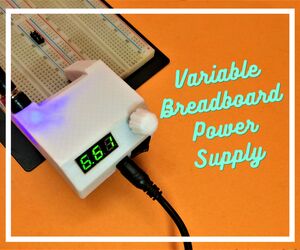
Variable Breadboard Power Supply
"Power supplies are the most basic tool every DIY / maker / electro-enthusiast should have. While the lab bench power supplies are great but you can't carry them everywhere and that's why you need a portable power supply, but they are generally restricted to 12-volt & 5-volt battery pack and to create a variable supply from that you need some circuitry which consumes some space in the breadboard. Also, the variable supply made with LM317 type linear regulator can't provide enough current, and because it is a linear supply it wastes a lot of energy and can't provide output voltage greater than the input. In this Instructables, I am going to show how I created a portable compact and efficient variable power supply that can provide from 0 volts to 30 volts with 1.5 amperes using very few components. Supplies: 3 Digits Digital Voltmeter XL6009 Buck Boost Module 7805 Regulator SMD 10K Ohm Potentiometer 10uF / 100uF Electrolytic Capacitor 10nF Ceramic Capacitor Male/Female 2.54 Headers SPST Power Switch 5mm LED and Resistor DC Barrel Jack 12V AC/DC Adapter and some 3D Printer Parts. For PCB Manufacturing (If you preparing PCB yourself) A4 Glossy sheet Copper Clad FeCl3 Marker and Laser Printer" [...]
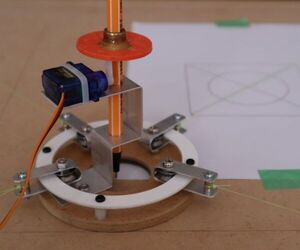
4-Wire Horizontal Plotter
"This instructable explains how to make a 4-wire plotter using the wheel-rims from a toy car, four stepping motors, a scrap of sheet aluminium, some pulleys, and an Arduino UNO R3. Unlike 2-wire vertical plotters the drawing surface for this plotter is horizontal. Construction is simple: the “base” requires a ruler, a few drills and a saw. the “gondola” requires an electric drill, a set of circle cutters, and a sharp knife. Features include: an on-board interpreter that recognizes the g-code output from “Inkscape”. accurate ... approximately 1mm with nylon scaleable ... just increase the cable lengths easy to make low cost The estimated cost of parts, excluding the power supply, is less than $100." [...]
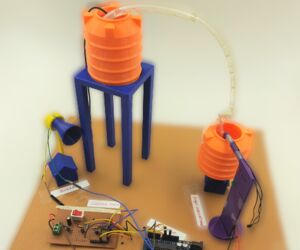
Microcontroller Based Water Level Controller With Water Level Indicators and Auto-cutoff
"People generally worry about the wastage of water when they switch ON the motor and forget to switch OFF the motor. This project may help them in saving water for the future. A water level detector is used to control the water level in the tank. In many industries like chemical, there is a restriction on the liquid level of the container in such cases level controller can maintain a level of the liquid at the desired level. The device works on the principle that the water is capable of passing a current through it. One wire which is connected to VCC is left in the bottom-most part of the tank and the rest wires are set at different levels in the tank." [...]
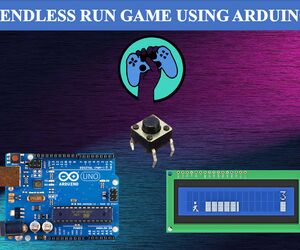
Arduino Endless Run Game Using LCD Display & Push Button
"In this tutorial we are going to build a simple "Arduino Endless Run Game Using LCD Display & Push Button." This is very simple & DIY game which we are going to make in this project we use LCD I2C module to reduce circuitary. so this is our first game using arduino, so let's make it. " [...]
Arduino Nano NeoPixel Shield With Integrated RTC
""Hello folks and welcome to my 25th Instructable, the Arduino NeoPixel Shield. It's my first one for a while so forgive me if I'm a little rusty, but it sure is good to be back! Here we have a small custom PCB that was designed using Autodesk's EAGLE and professionally manufactured by OSH Park in the USA. It includes an Integrated real-time-clock (or RTC), various I/O headers and support for an external power supply (either connected by a DC jack or via a screw terminal block). The main purpose of this board is to allow NeoPixel (WS2812 LED) strips to be easily connected to an Arduino Nano and to provide everything that is required to have a reliable, convenient and versatile way of using them in Arduino based projects. NeoPixels are already pretty easy to wire up to an Arduino, but this makes everything that little bit neater and much more practical for 'professional' type permanent installs of your LED strips." [...]
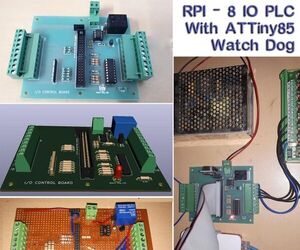
RPI - 8 IO PLC With ATTiny85 Watch Dog
"This Project is the starting of a big project which control a big process in low cost. I choose raspberry pi and its my first project in pi. I already work with i/o controllers for my official project, and also work with some plc and scada. But here when use raspberry pi we can able to save data in the pi data base and also have GPIO pins for io controllers. But for process we want some isolated Outputs to safe guard the raspberry pi. First i design the circuit in the prototype board and after complete the project i make a sketch and print pcb." [...]

The Bolt! - an Electric Go Kart Homeschool STEM Project
"Let's not talk about how crazy this year has been... that goes without saying! As a result of all the craziness my wife and I decided that this would be a great year to homeschool our two kids, Rosalie (9) and Vincent (7). Although the school I teach at is "in session" it hasn't been particularly consistent, with the start of the school year being fully remote and now, at the halfway point, we are doing a hybrid schedule. Being home during the remote portion of the year really gave me a chance to spend some quality time working with my own kids in the realms of science and technology. We did a lot of fun lessons during the evenings and weekends that hit upon topics ranging from circuits to rock formation. But, I wanted to do something really cool that would have piles of integrated lessons... in rolls the go kart!" [...]

ESP32-Cam Programmer
"ESP32-Cam is a compact size and low cost ESP32 Development board with OV2640 camera. There's no USB programming port, so you need external programmer like FTDI, CH340 or CP2102 to upload code through serial pins (UOR and UOT). While it is extremely popular, the ESP32-Cam has several issues. One of common issues of this development board is mostly failed to upload the code. The Arduino IDE will tell you that it "Failed to connect to ESP32: Timed out waiting for packet header". You have to check the wiring between ESP32-Cam and the FTDI as image shown above." [...]
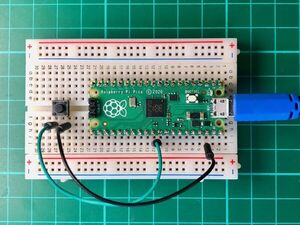
How to add a reset button to your Raspberry Pi Pico
"We’ve tried to make it as easy as possible for you to load your code onto your new Raspberry Pi Pico: press and hold the BOOTSEL button, plug your Pico into your computer, and it’ll mount as a mass storage volume. Then just drag and drop a UF2 file onto the board. However, not everybody is keen to keep unplugging their micro USB cable every time they want to upload a UF2 onto the board. Don’t worry — there’s more than one way around that problem. Firstly, if you’re developing in MicroPython there isn’t any real need to unplug and replug Pico to write code. The only time you’ll need to do it is the initial upload of the MicroPython firmware, which comes as a UF2." [...]
That's all Folks!



